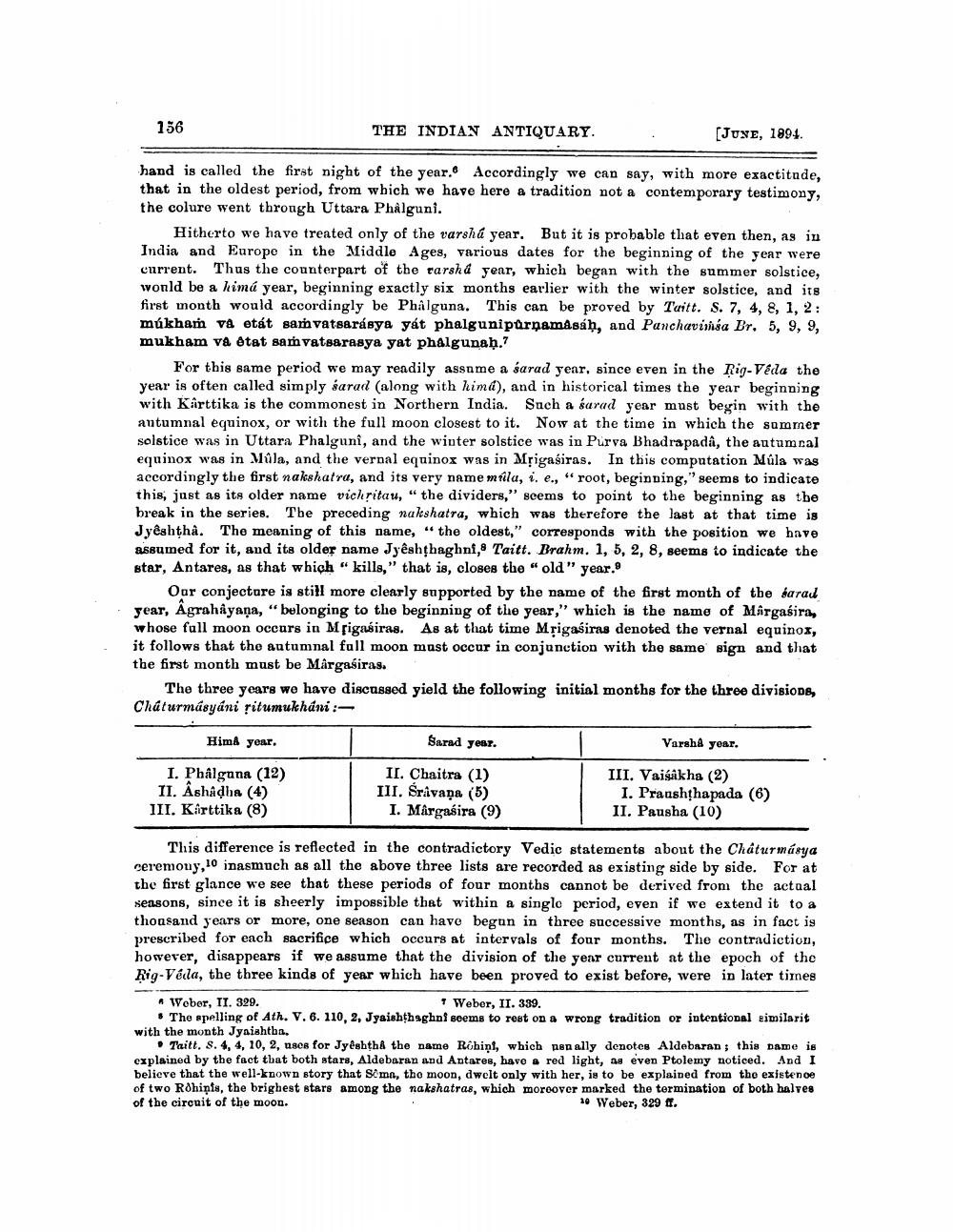________________
156
THE INDIAN ANTIQUARY.
[JUNE, 1894.
hand is called the first night of the year. Accordingly we can say, with more exactitude, that in the oldest period, from which we have here a tradition not a contemporary testimony, the colure went through Uttara Phalguni.
Hitherto we have treated only of the varsha year. But it is probable that even then, as in India and Europe in the Middle Ages, various dates for the beginning of the year were current. Thus the counterpart of the rarshd year, which began with the summer solstice, would be a hima year, beginning exactly six months earlier with the winter solstice, and its first month would accordingly be Phalguna. This can be proved by Taitt. S. 7, 4, 8, 1, 2: múkham va etát samvatsarásya yát phalguni purnamasaḥ, and Panchavimsa Br. 5, 9, 9, mukham va êtat samvatsarasya yat phalgunaḥ.7
For this same period we may readily assume a sarad year, since even in the Rig-Véda the year is often called simply sarad (along with hima), and in historical times the year beginning with Karttika is the commonest in Northern India. Such a sarad year must begin with the autumnal equinox, or with the full moon closest to it. Now at the time in which the summer solstice was in Uttara Phalgunî, and the winter solstice was in Purva Bhadrapadâ, the autumnal equinox was in Mûla, and the vernal equinox was in Mrigasiras. In this computation Múla was accordingly the first nakshatra, and its very name mila, i. e., "root, beginning," seems to indicate this, just as its older name vichritau, "the dividers," seems to point to the beginning as the break in the series. The preceding nakshatra, which was therefore the last at that time is Jyeshtha. The meaning of this name, "the oldest," corresponds with the position we have assumed for it, and its older name Jyêshthaghni,8 Taitt. Brahm. 1, 5, 2, 8, seems to indicate the star, Antares, as that which "kills," that is, closes the "old" year.9
Our conjecture is still more clearly supported by the name of the first month of the sarad year, Agrahayana, "belonging to the beginning of the year," which is the name of Margasira, whose full moon occurs in Mrigasiras. As at that time Mrigasiras denoted the vernal equinox, it follows that the autumnal full moon must occur in conjunction with the same sign and that the first month must be Mârgasiras.
The three years we have discussed yield the following initial months for the three divisions, Chaturmasyáni ritumukháni:
Himå year.
I. Phâlguna (12) II. Ashadha (4) III. Karttika (8)
Sarad year. II. Chaitra (1) III. Śravana (5)
I. Mârgasira (9)
Varsha year.
III. Vaisakha (2)
I. Praushthapada (6) II. Pausha (10)
This difference is reflected in the contradictory Vedic statements about the Châturmasya ceremony, 10 inasmuch as all the above three lists are recorded as existing side by side. For at the first glance we see that these periods of four months cannot be derived from the actual seasons, since it is sheerly impossible that within a single period, even if we extend it to a thousand years or more, one season can have begun in three successive months, as in fact is prescribed for each sacrifice which occurs at intervals of four months. The contradiction, however, disappears if we assume that the division of the year current at the epoch of the Rig-Véda, the three kinds of year which have been proved to exist before, were in later times
Weber, II. 329.
Weber, II. 339.
The spelling of Ath. V. 6. 110, 2, Jyaishthaghni seems to rest on a wrong tradition or intentional similarit with the month Jyaishtha.
Taitt. S. 4, 4, 10, 2, uses for Jyêshtha the name Rohini, which usually denotes Aldebaran; this name is explained by the fact that both stars, Aldebaran and Antares, have a red light, as even Ptolemy noticed. And I believe that the well-known story that Soma, the moon, dwelt only with her, is to be explained from the existence of two Rohinis, the brighest stars among the nakshatras, which moreover marked the termination of both halves of the circuit of the moon. 10 Weber, 329 ff.




